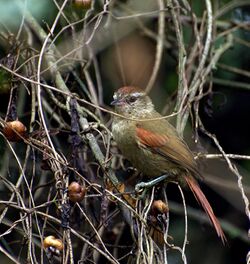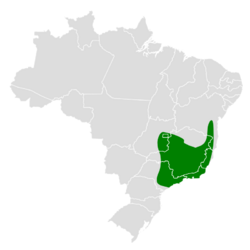Biology:Pallid spinetail
| Pallid spinetail | |
|---|---|

| |
| Scientific classification | |
| Domain: | Eukaryota |
| Kingdom: | Animalia |
| Phylum: | Chordata |
| Class: | Aves |
| Order: | Passeriformes |
| Family: | Furnariidae |
| Genus: | Cranioleuca |
| Species: | C. pallida
|
| Binomial name | |
| Cranioleuca pallida (Wied, 1831)
| |

| |
The pallid spinetail (Cranioleuca pallida) is a species of bird in the Furnariinae subfamily of the ovenbird family Furnariidae. It is endemic to Brazil .[2]
Taxonomy and systematics
The pallid spinetail is monotypic.[2] It and the stripe-crowned spinetail (C. pyrrhophia) are sister species, and the two are closely related to the olive spinetail (C. obsoleta).[3]
Description
The pallid spinetail is 14 to 15 cm (5.5 to 5.9 in) long and weighs 11 to 12 g (0.39 to 0.42 oz). It is a smallish member of genus Cranioleuca. The sexes have the same plumage. Adults have a wide whitish supercilium, a blackish spot in front of the eye, a dark brown band behind the eye, and buffy ear coverts with faint dark brownish streaks. Their forehead is streaked blackish and buff, their crown is dark rufous, and their nape gray. Their back and rump are tawny-olive or olive-brown. Their tail is dark rufous; the feathers are graduated and lack barbs at the end giving a spiky appearance. Their wing coverts are rufous, their primary coverts dark brown, and their flight feathers pale cinnamon-tawny to pale olive-tawny. Their chin is buffy whitish, their throat and breast bright buffy to brownish olive, their belly duller pale brownish olive, and flanks and undertail coverts slightly darker. Their iris is reddish brown to pale brown, their maxilla black to dusky horn, their mandible pinkish with a dusky tip, and their legs and feet greenish olive or gray. Juveniles have a darker back than adults, with a brown crown, ochraceous-tinged underparts, and variable dark mottling on the breast.[4][5]
Distribution and habitat
The pallid spinetail is found in southeastern Brazil from southern Goiás, central Minas Gerais, and southeastern Bahia south into eastern Paraná. It inhabits montane evergreen forest, woodlands, and mature secondary forest. In elevation it ranges from 700 to 2,150 m (2,300 to 7,100 ft).[4][5]
Behavior
Movement
The pallid spinetail is a year-round resident throughout its range.[4]
Feeding
The pallid spinetail feeds on arthropods. It typically forages in pairs and usually joins mixed-species feeding flocks. It acrobatically gleans prey from vines, dead leaves, bark, trapped debris, fruit, and flowers. It hitches and climbs along small branches from the forest's mid-storey to its canopy.[4][5]
Breeding
The pallid spinetail is thought to be monogamous and to breed in the austral spring and summer. Its nest is a globe of lichen and moss with a side entrance, typically placed on a tree branch against the trunk or atop a clump of epiphytes. The clutch size, incubation period, time to fledging, and details of parental care are not known.[4]
Vocalization
The pallid spinetail's song is an "extr. high, slightly descending series of about 5 'seetseet---tut' notes (often accelerated to a trill at the end)".[5] Its call is "tééé-ssik, tséé-ssik".[4]
Status
The IUCN has assessed the pallid spinetail as being of Least Concern. It has a large range and an unknown population size that is believed to be decreasing. No immediate threats have been identified.[1] It is considered fairly common to common and occurs in a few protected areas. However, "[e]xtensive deforestation within its relatively small range has dramatically reduced available habitat".[4]
References
- ↑ 1.0 1.1 BirdLife International (2016). "Pallid Spinetail Cranioleuca pallida". IUCN Red List of Threatened Species 2016: e.T22702417A93874287. doi:10.2305/IUCN.UK.2016-3.RLTS.T22702417A93874287.en. https://www.iucnredlist.org/species/22702417/93874287. Retrieved 14 November 2023.
- ↑ 2.0 2.1 Gill, Frank; Donsker, David; Rasmussen, Pamela, eds (July 2023). "Ovenbirds, woodcreepers". https://www.worldbirdnames.org/new/bow/ovenbirds/.
- ↑ Derryberry, E. P., S. Claramunt, G. Derryberry, R. T. Chesser, J. Cracraft, A. Aleixo, J. Pérez-Emán, J. V. Remsen, Jr., and R. T. Brumfield. (2011). Lineage diversification and morphological evolution in a large-scale continental radiation: the Neotropical ovenbirds and woodcreepers (Aves: Furnariidae). Evolution 65(10):2973–2986. https://doi.org/10.1111/j.1558-5646.2011.01374.x
- ↑ 4.0 4.1 4.2 4.3 4.4 4.5 4.6 Remsen, Jr., J. V. (2020). Pallid Spinetail (Cranioleuca pallida), version 1.0. In Birds of the World (J. del Hoyo, A. Elliott, J. Sargatal, D. A. Christie, and E. de Juana, Editors). Cornell Lab of Ornithology, Ithaca, NY, USA. https://doi.org/10.2173/bow.palspi1.01 retrieved November 14, 2023
- ↑ 5.0 5.1 5.2 5.3 van Perlo, Ber (2009). A Field Guide to the Birds of Brazil. New York: Oxford University Press. pp. 216. ISBN 978-0-19-530155-7.
Wikidata ☰ Q869489 entry
 |


